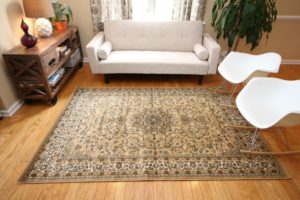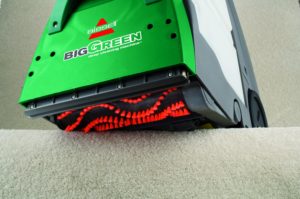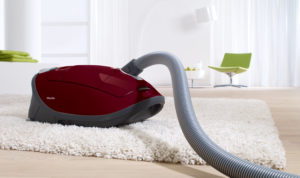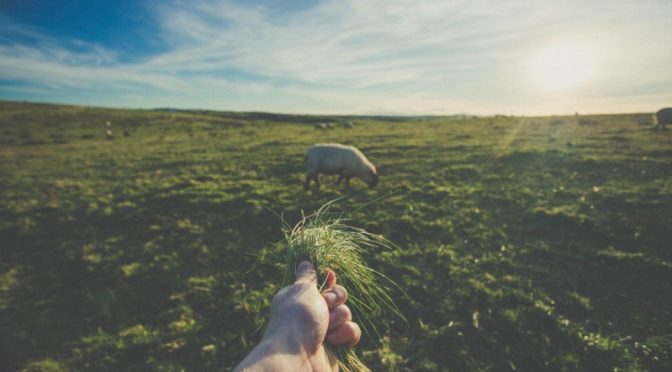
If you’re choosing a carpet for your home, one of the most basic decisions you’ll have to make involves the fiber the carpet is made from. On a broad level, there are two options: natural or synthetic. If you want a synthetic fiber, as most people do, we recommend nylon or triexta. But if you want a natural carpet fiber, we’ll typically recommend wool, which is the most popular natural material in carpeting and has been so for years. Today we’ll take an in depth look at wool as a carpet fiber, focusing on its durability, maintenance requirements, staining and soiling resistance, and where it works best (and worst) in a home.
Overall, what are the pros and cons of buying a wool carpet or rug?

The advantages of wool as a carpet and rug fiber include its natural origins (it’s basically sheep fur), its strength, stain and fire resistance, and sound and heat-insulating properties. It’s also soft and gentle against skin and has natural resistance to small amounts of water. The disadvantages of wool are tied to its price–you’ll pay at least $3 per square foot and will typically pay at least $10 or $13 per square foot–and its susceptibility to mold and mildew. As a natural, breathable fiber, it’s also far more picky than synthetic fibers when it comes to cleaning it safely.
How durable is wool compared to synthetic fibers like nylon?
Wool is one of the most resilient natural fibers out there, but it’s not as resilient as certain synthetic fibers, such as nylon. Resiliency has to do with how well a fiber regains its original volume after being compressed, such as by a foot walking over it or a child sitting on it. The degree of resilience in wool gives it considerable texture retention. In other words, wool keeps looking the way it originally did when you bought it for a long time. As a result, a wool carpet or rug can last for years with care, although it will be more sensitive to abrasion than some of the tougher synthetic fibers on the market (e.g., triexta). When cared for, wool carpets and rugs can easily remain in excellent condition for decades.
What does it take to clean and maintain wool carpeting?
Despite what you may have heard, it is possible to maintain wool carpets and rugs without calling in professional cleaners, but you do need to know what you’re doing. When cleaning wool incorrectly, you run the risk of shrinking it; this is where some people’s fears of so much as walking by wool with carpet cleaning solutions comes from.
We’ll cover the details on how to clean wool properly in a different article, but the general points are to use cool or lukewarm water for cleaning, to use as little water as possible, to vacuum before any actual cleaning, to dry the fibers with ventilation and fans, and above all, to test your cleaning solution on a small section of the fiber before using it everywhere to ensure that you won’t run into staining issues.
How stain, soil, and flame resistant are wool carpets?
Compared to most synthetic fibers (e.g., olefin), wool won’t offer as much stain resistance. The fiber is naturally highly absorbent, and getting stains out of it once absorbed will be a challenge. We recommend the same approach as we would with all fibers–prevent stains by treating spills as soon as you can once they occur, whether they occur from red wine, orange juice, coffee, or other liquids. With wool, you might not get a second chance once the liquids have fully soaked themselves into the fibers.
There is a difference between soiling and staining when it comes to carpet care (and warranty coverage). Wool, unlike olefin or a number of other synthetic fibers, is highly soil resistant. These properties come from its design as a natural fiber. On a microscopic level, wool is somewhat scaly. The scales make it hard for dirt to embed itself in carpets, which reduces the risk of soiling through contact with oils from feet or cleaning products. The scales are also light dispersive, which essentially means they hide soiling from showing easily.
Wool has an impressive amount of flame resistance–much more than those of synthetic fibers, which are all essentially various forms of petroleum (what we turn into gasoline). Wool doesn’t burn at normal temperatures; it simply chars, or blackens. This makes it a good choice for carpeting in areas with a higher-than-average risk of fire hazards (e.g., homes with smokers or beside fireplaces and stoves). That said, we still don’t recommend using it–or any carpeting–close to open flames or sparks.
Where does wool carpeting work well and poorly in a home?
Given the pros and cons of wool rugs and carpeting, we’d recommend using it in primarily dry areas such as living and family rooms, nurseries, and bedrooms. We’d keep it away from damp or humid areas, including bathrooms, kitchens, and basements in order to avoid mold and mildew issues that come from moisture retention.
Wool also works as a natural humidifier, which means it can work well in otherwise dry homes, as it will generally absorb moisture from humid air and release it into the air when it dries. On the other hand, you might also want to consider a dehumidifier if you’re interested in wool rugs or carpets in climates with constant temperatures and high humidity levels.
Which carpet cleaners and vacuums are best for cleaning and maintaining wool rugs and carpets?

While you can technically use almost any carpet cleaner or vacuum to clean a wool carpet or rug if you know what you’re doing, we tend to recommend hardy, buy-it-for life machines that will clean safely while staying out of landfills for as long as possible. For carpet cleaners, we recommend the Bissell 86T3 Big Green. As we’ve repeatedly noted, (e.g., here and here), it’s the kind of cleaner you can potentially pass down to your children, and it’ll do a better job than just about anything else under $1,000.

For vacuuming, we recommend investing in the Miele Complete C3 Soft Carpet or the Miele Compact C2 Electro+. Both are durable, high-end machines with a range of settings to allow you to effectively clean wool and other piles and styles without damaging them. The Soft Carpet, in particular, will clean carpets nearly no other vacuum can, while the Electro+ is a low-priced alternative for families that don’t need to clean soft carpets but do want a buy-it-for-life machine with the ability to deal with everything from bare floors to high pile carpeting in one canister.
![]() You can buy the Bissell 85T3 Big Green carpet cleaner here on Amazon. You can buy the Miele Complete C3 Soft Carpet here or buy the Miele Compact C2 Electro+ here. You can buy the beautiful Persian wool rug above here.
You can buy the Bissell 85T3 Big Green carpet cleaner here on Amazon. You can buy the Miele Complete C3 Soft Carpet here or buy the Miele Compact C2 Electro+ here. You can buy the beautiful Persian wool rug above here.
![]() Canadians can buy the Miele Soft Carpet here, the Compact Electro+ here, and the Bissell Big Green here.
Canadians can buy the Miele Soft Carpet here, the Compact Electro+ here, and the Bissell Big Green here.
 If you find our research on PMC helpful, you can follow our efforts to keep maniacally reviewing home cleaning tools by shopping through our links above. We promise to keep fighting the good fight against every horror children, animals, and grown, yet messy humans can inflict upon a clean home.
If you find our research on PMC helpful, you can follow our efforts to keep maniacally reviewing home cleaning tools by shopping through our links above. We promise to keep fighting the good fight against every horror children, animals, and grown, yet messy humans can inflict upon a clean home.

